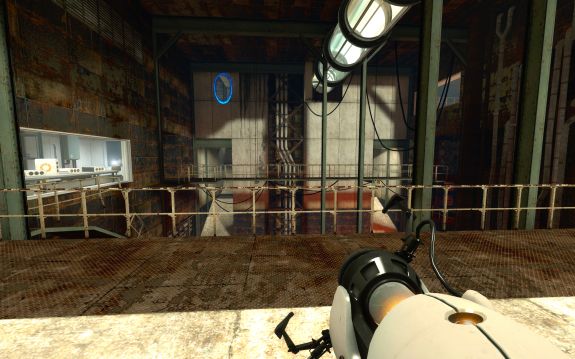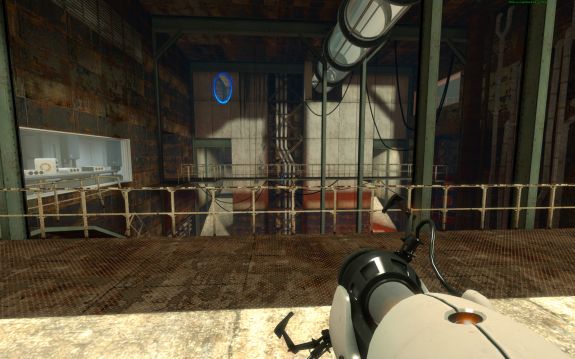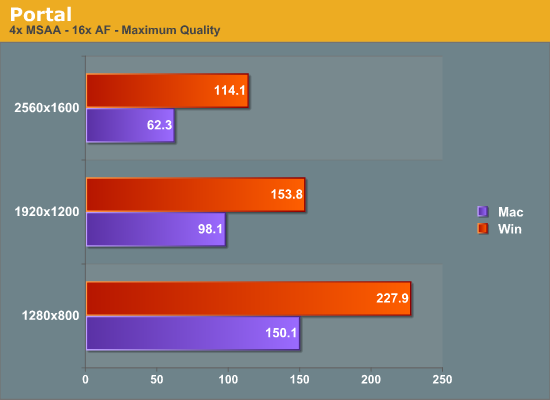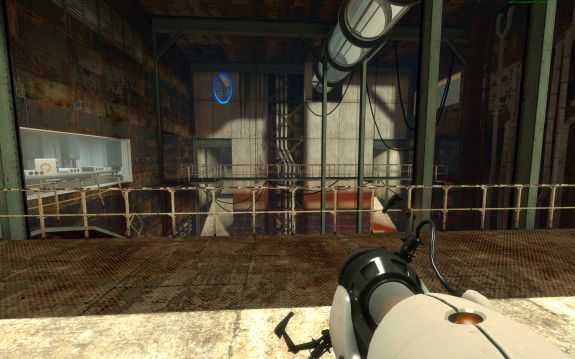Update 5/15/2010: Valve released a new patch for Portal on the 13th which resolved the blurriness issue. Please see our update below for for the full details.
It’s been a while since anyone treated Mac OS X as a first-tier gaming platform, so when Valve announced that they would be bringing their Steam service and the Source engine to the Mac, it was big news. After a roughly 2 month beta period for the Mac versions of Steam and the Source engine, yesterday Valve finally released the first wave of their Mac gaming efforts.
As it stands Valve is taking a gradual approach to rolling out their back catalog to the platform. Even though Steam is out and the Source engine has been ported, this week has seen the release of only 1 Source game for the Mac: 2007’s critically acclaimed Portal.
While it’s not the most graphically intensive Source game these days (that title belonging to Left 4 Dead), at this point it’s as good as anything else for looking at the performance of the Source engine under Mac OS X, particularly considering how long it’s been since a game’s original developer did the Mac port. So with that in mind, we went ahead and took a quick look at Portal’s performance under Mac OS X.
As is the case with all of the games on the Source engine, they’re designed to scale up and down fairly well. With modern hardware though, we’re hard-pressed to keep older Source games from achieving runaway frame rates. So Portal performance is somewhat arbitrary – most Macs with a discrete GPU should be able to handle it to an acceptable degree.
The Test
For our test we loaded up our GPU test rig with Mac OS X 10.6.3 in a Hackintosh configuration. As Mac OS X does not currently support either the GeForce GTX 400 series or the Radeon HD 5000 series, we had to step back a bit with our video card choice, settling for a GeForce GTX 285. And while the use of a Hackintosh does technically invalidate our results since it’s not a real Macintosh, based on our experiments we believe that our results don’t suffer in any way for using a Hackintosh, and as such we believe the results to be experimentally valid. But of course, your mileage may vary.
| CPU: | Intel Core i7-920 @ 3.33GHz |
| Motherboard: | Intel DX58SO (Intel X58) |
| Chipset Drivers: | Intel 9.1.1.1015 (Intel) |
| Hard Disk: | OCZ Summit (120GB) |
| Memory: | Patriot Viper DDR3-1333 3 x 2GB (7-7-7-20) |
| Video Cards: | NVIDIA GeForce GTX 285 |
| Video Drivers: | NVIDIA ForceWare 197.13 |
| OS: |
Windows 7 Ultimate 64-bit Mac OS X 10.6.3 "Snow Leopard" |
Image Quality
We’ll start quickly with a look at image quality. Valve is traditionally a staunch Microsoft ally, having built up their services and engines around Windows and DirectX. For the Mac OS X port of Source, Valve had to replace the DirectX backend of Source with Mac-appropriate components, the key of which is OpenGL. Such a change can impact image quality depending on how it’s done.

Portal - Windows. Click to enlarge

Portal - Mac OS X. Click to enlarge.
We have a gallery of screenshots, but for our analysis we’ll stick with comparing in a single set. Going with 2560x1600 with the game at its highest settings and 4xAA/16xAF, to our surprise the images are distinctly different when directly compared. The Mac screenshot is noticeably foggier than the Windows image, and textures appear to be less sharp. It’s not a night & day difference, but the Windows screenshot is distinctly clearer than the Mac screenshot. Without a Windows reference image it would be harder to tell that the Mac screenshot differs this much, but we believe that the difference is great enough that anyone with an eye for details that has ever played Portal on Windows would notice the foggier/blurrier IQ on the Mac.
Now some of this can be explained away due to gamma, since Mac OS X and Windows have different default gamma levels, but gamma could never explain the entire difference. There’s clearly a difference in IQ between the Windows and Mac OS X versions of Portal, and it’s not in the Mac’s favor. It’s by no means bad, but as one person put this when being shown these screenshots “It’s like looking at a magazine scan” when looking at the Mac.
Performance
The other half of our quick look is at performance. The Macintosh platform is renowned for being a graphical powerhouse, but this refers to professional/prosumer photography and the like. For gaming, Apple has been slow to include support for new hardware and new driver features (they are just now OpenGL 3.0 compliant) and overall their drivers are more conservative when it comes to performance. Portal is going to be slower, the question is by how much.

We went ahead and ran a timedemo from test chamber 18 and beyond on both the Mac OS X and Windows versions of Portal. We kept the settings cranked up at all times, but varied the resolution between 1280x800 and 2560x1600 to look at different GPU loads. At the worst-case of 2560, the Mac version of Portal runs at only 54% of the speed of the Windows version. That moves to 63% at 1920x1200, and 66% at 1280x800.
Portal – like all Source engine games – is CPU limited when given a powerful enough GPU, and even with just a GTX 285 we can approach that under Windows. Under Mac OS X however, we look to be GPU limited at all times. The framerate never suffers as we’re always averaging more than 60fps, but we can easily turn off MSAA and AF to improve performance if we needed to.
Closing Thoughts
For Source engine enthusaists hoping to see the Mac OS X port of the Source engine meet the high standards of the Windows version, Portal presents a mixed bag. In our limited testing the Mac version of Portal doesn’t significantly suffer for being a port, but at the same time it can’t quite match the image quality of the Windows version. Feature-for-feature there is parity, but the Mac version just isn’t as sharp as the Windows version.
Performance isn’t any better. Portal is an easy game to run and so we’re largely being academic here, but the “tax” for Mac OS X is roughly a generation in hardware performance. For the performance we’re seeing on a GTX 285 under Mac OS X the results are similar to what we’d see under Windows with something like a 9800GTX. Given that at the high-end the Mac platform is also a generation behind in hardware, and you’re looking at 2008 performance for Portal even with the best hardware you can get today for a Mac.
Ultimately having the Source engine ported to Mac OS X is going to remove the technical need to use Bootcamp to run Windows for games, but based on Portal it doesn’t remove the need to boot Windows for performance reasons. For long-time Mac users none of this should be surprising, but it means that we shouldn’t expect the Mac OS X version of the Source engine to be revolutionary.
Update: 5/15/2010
On Thursday after we published our article Valve pushed out an update for Portal that focused on fixes for the Mac version. The big fix was the following:
Fixed screen "fuzziness" caused by color correction operation
This fixed the blurriness issue we saw with the initial version of Portal. Texture and geometry quality is now as sharp as it is under Windows. Performance remains unchanged, while there is still an image quality difference between the two due to lighting differences and a general degree of fogginess that still appears on the Mac OS X version.























178 Comments
View All Comments
t0njohn - Thursday, May 13, 2010 - link
OpenGL is not supported on the PC in Source engine games. The OpenGL code is only part of the Mac build. Feel free to look up quotes from Valve engineer Rob Barris (rbarris on forums.steampowered.com).JSt0rm01 - Thursday, May 13, 2010 - link
So a hacked install of osx doesnt play the game as well as the windows 7 install?Was that a fair comparison? I dont think so...
If you look at xbench results for hackintosh computers they do stellar in cpu performance but when you get into the lower level tests they come up short. Reason? I don't know. Hate mac all you want but if you take this anecdotal as proof these computers and os are bad you do yourself a disservice.
Why don't they pull out anand's macpro and put that up against a comparable pc if they really want to see?
I own both btw and I game on my pc and work on my mac.
Scali - Thursday, May 13, 2010 - link
These tests don't show any problems with Hackintosh performance:http://lifehacker.com/322866/hackintosh-vs-mac-pro...
The Mac Pro is only faster in the threading test, which is no surprise as it is a dual CPU system and the Hackintosh is single CPU.
Other than that, the Hackintosh keeps up just fine with the real Macs.
marraco - Thursday, May 13, 2010 - link
OSX gives a generation lower performance... and if you buy a mac instead of a hackintosh, you have another generation slower hardware.And that with lower quality graphics
SoneeOO7 - Thursday, May 13, 2010 - link
PLAIN AND SIMPLEt0njohn - Thursday, May 13, 2010 - link
You are wrong, plain and simple.Mad1723 - Thursday, May 13, 2010 - link
Hey there Anandtech,There was a patch released for Portal today. In the bugs fixed, there was a mention of screen "fuzziness", which sounds like the image quality issue you had during your tests! Maybe you should try again to see if it's fixed now :D
Changelog:
http://store.steampowered.com/news/3825/
Mad1723
Ryan Smith - Friday, May 14, 2010 - link
Thanks, I'll have to look in to that.Also, to whomever responded to the parent, I accidentally deleted your post when trying to copy your link. Sorry about that.
IntelUser2000 - Thursday, May 13, 2010 - link
Despite the fact that Microsoft and Windows are a laughing stock in tech forums, practically they do very well. It's probably not just OpenGL that makes Portal port on Mac slower, but its just way better optimized on Windows.Aside from some retarded implementations(ME and *cough* Vista), Windows is generally very well optimized for productivity and gaming.
Take for example the so-called "thread-bouncing" that occurs in Windows. Think that's merely MS's evil schemes to screw you up?
Scali - Friday, May 14, 2010 - link
Well, in Vista's defense... gaming performance is just fine in Vista. Granted, it wasn't that great initially, but after a few Windows updates and nVidia/AMD getting the hang of the new driver model, it's just fine now. Hardly any difference with Windows 7.Aside from that... yes I very much agree with your point. People always claim that Windows is slow and crappy, and that linux/OS X/whatever other esoteric OS is so much more efficient. Likewise they always hail OpenGL as a drop-in replacement for Direct3D.
Well, those claims are easy to sustain when there simply aren't any games to make direct comparisons... but now there is such a game, and we can all see what the results are.
I'd like to add that this isn't even a very new game, or a graphically complex one. It's a DirectX 9 game, and not even using all that much eyecandy, and there isn't a whole lot going on inside the game. It's not an action game, so there aren't lots of characters and vehicles moving around on screen.
I wonder what the OpenGL version of the engine would do on Windows. It would give an indication of how much of the performance is related to the OS itself, and how much is related just to OpenGL vs Direct3D.
Being a developer of both OpenGL and D3D code myself, I've seen similar things. I haven't used a Mac though (although my code is open source, and should compile on a Mac as-is, you could try the sample program from here: http://sourceforge.net/projects/bhmfileformat/)... But in general the OpenGL version of the code is not as fast as the exact same code in D3D... and running the OpenGL code on linux or FreeBSD is way slower than the same code on Windows. I wonder where OS X fits in there. My guess is somewhere between linux and Windows.